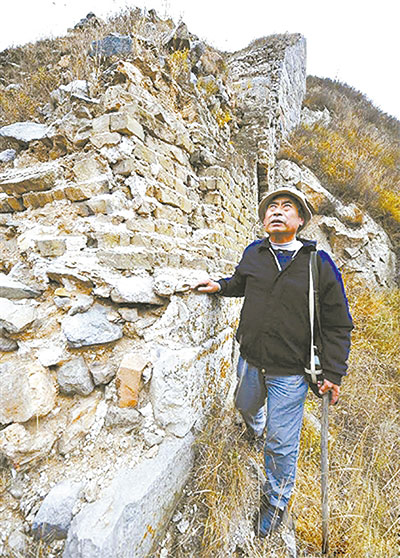
MEANDERING on mountain ridges across North China, the Great Wall, one of the world’s great wonders, has for thousands of years protected residents from invasion. Gone are the beacons and soldiers on the mountain tops. But another group of rangers has appeared, protecting the ancient landmark from a new kind of invasion. In Yanqing District, on the northern outskirts of Beijing, home to a 179-km-long section of the Great Wall, a team of more than 60 government-employed rangers and some 200 volunteers have ensured that there is no further man-made destruction of the centuries-old wall. Mei Jingtian, 73, is the oldest of them. He lives in Shixia Village near Badaling, where the oldest sections of the Great Wall have been dated back to the Northern Qi Dynasty (550-557). “I grew up at the foot of the Great Wall and it was an important part of my childhood,” he said. Mei remembers the imposing wall of his youth, before it went through massive destruction during the Culture Revolution in the 1960s and the 1970s, when it was considered a remnant of feudal history to be pulled down. During that time, some locals even took bricks from the ancient wall to build their houses. The Great Wall, a symbol of China, is actually not just one wall, but many interconnected walls built between the third century B.C. and the Ming Dynasty (1368-1644). It was listed as a World Heritage Site by UNESCO in 1987, but its preservation faces long-term challenges. According to the Yanqing cultural relics authority, only 10 percent of the Great Wall in the district has been protected, 15 percent has completely disappeared and the rest is in ruins. Mei became a voluntary ranger in 1983. Carrying a bottle of water and a sickle, he leaves home at dawn, humming an old song while picking up the garbage and weeding around the foot of the Great Wall. He walks around 20 kilometers each day. Over the decades, he has worn through more than 200 pairs of shoes. “I feel reassured standing on the mountain,” he said. “The Great Wall is unique. If we don’t do anything, I think one day it might disappear completely.” Human activity once posed the greatest threat to the Great Wall, and was hard to stop. Mei was often told “don’t meddle in others’ business.” Once he approached a group of men inscribing characters on the bricks with a knife, who then surrounded and tried to intimidate him. “I told them the importance of protecting the Great Wall and was able to make them leave,” he recalled. In 2007, Mei founded a 40-member-strong association for Great Wall protection. “Now the number has doubled,” he said, adding that they run activities all year round, mobilizing Communist Party members and even primary school students to take part in mountain patrols, picking up garbage, and checking geological risks along the wall. His story has inspired many others to follow suit. Liu Huijun, 43, from central China’s Hubei Province, who was stationed in Shixia village as a soldier in 1993, became a ranger in 2007. “Public awareness of the need to protect the Great Wall has increased,” said Liu, now a police officer. On important festivals, activities are held at the foot of the Great Wall. In Shixia, about one third of the villagers have joined the protection efforts. Although man-made destruction has been virtually stopped, the process of natural erosion has picked up speed. “Some Great Wall sections have brick walls and stairs. However, most stretches of the wall were built with rocks and earth foundations,” said Yu Haikuan from the Yanqing cultural relics authority. “Rainwater is very corrosive to dilapidated wall sections,” he said. Repairs are difficult to complete, taking large amounts of funding and manual labor, he added. “Not even a mule can climb up some of the steepest mountainsides. A worker can only carry three bricks at a time, 15 kilograms each, around 18 bricks a day at the most,” said Yu. Rebuilding a 1-meter section of the Great Wall costs approximately 10,000 yuan (US$1473). The government approved a Great Wall repair fund of 60 million yuan in 2016, with 20 million of that designated for repairs to the Badaling section, the tourist area commonly seen on TV and postcards. “The most pressing task is to renovate a 7-kilometer section along the route to the 2022 Winter Olympic venue and the 2019 World Horticultural Exhibition site,” Yu said. Yu has mixed feelings about the Great Wall. To protect the visual landscape of the wall, building heights have been limited in nearby areas, which led to the termination of an innovation base program about 5 kilometers away. “We had expected the program to boost the development of Yanqing,” he said. “Plans for Great Wall protection and local development should be drafted together. Only by doing that can we encourage more villagers to join protection efforts. Indeed we will suffer some losses,” Liu said. “But every coin has two sides. We should promote tourism to improve villagers’ lives.” (Xinhua) | 
